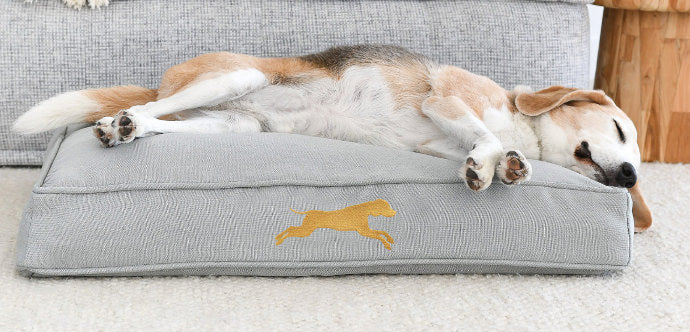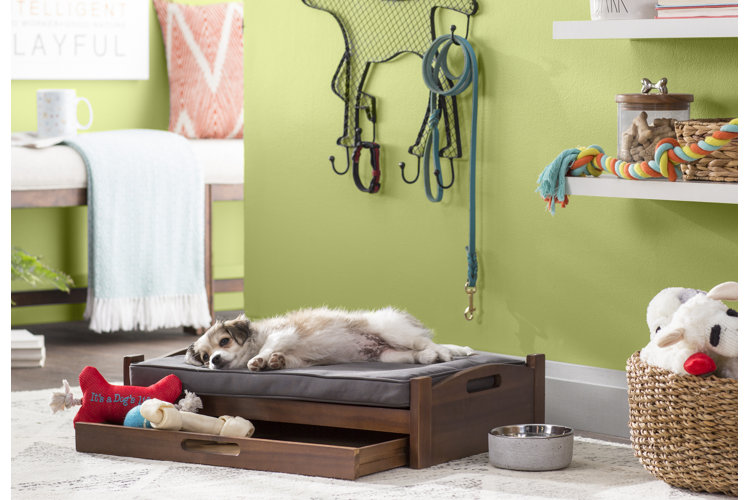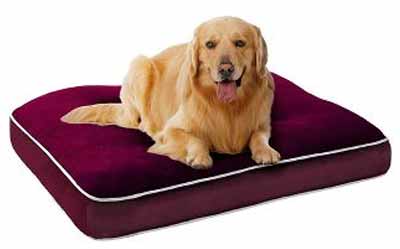If you’re a proud dog owner, you know that our furry friends deserve the absolute best, and that includes a comfortable place to rest their paws. But with so many options available, how do you choose the perfect bed for your beloved canine companion? From cozy nests to plush pillows, this article explores the world of dog beds, helping you find the ideal option that will have your pup snoozing in style and comfort. So read on to discover the ins and outs of selecting the perfect bed for your dog!

Choosing the Perfect Bed for Your Dog
When it comes to choosing a bed for your furry friend, there are several factors to consider. From the size of your dog to their sleeping position, age and health, and even your personal preferences, all these factors play a significant role in finding the perfect bed for your canine companion. Let’s dive into each of these factors and explore the different types of dog beds available to help you make an informed decision.
Size of the Dog
The size of your dog is perhaps one of the most crucial factors to consider when choosing a bed. Your furry friend deserves a bed that provides ample space for them to stretch and relax comfortably. Measure your dog from the tip of their nose to the base of their tail, and then add a few inches to determine the ideal bed size. Considering the size of your dog is crucial as it ensures proper support and comfort for your pet.
Sleeping Position
Just like humans, dogs have their own preferred sleeping positions. Some dogs prefer to sleep on their side, while others enjoy sleeping on their back, stomach, or even curling up. Knowing your dog’s sleeping position can help you choose a bed that accommodates their preferences and provides the necessary support for their body. For side sleepers, a soft and cushioned bed is ideal, while back sleepers may benefit from a bed with additional padding for spine support.
Age and Health
Your dog’s age and health should also be taken into consideration when selecting a bed. Puppies and young dogs may benefit from a bed that offers extra support for their growing bodies. On the other hand, senior dogs may require a bed that provides orthopedic support to alleviate joint pain and arthritis. If your furry friend has any specific health conditions or sensitivities, it’s essential to choose a bed that meets their needs and promotes their overall well-being.
Indoor or Outdoor
Another factor to consider is whether the bed will be placed indoors or outdoors. If you plan on placing the bed outdoors, it’s crucial to choose a weatherproof and durable option that can withstand the elements. Outdoor beds should also provide insulation to keep your dog warm during colder months. Additionally, if your furry friend spends a significant amount of time outdoors, an elevated design can help keep them off the ground and provide extra comfort.
Ease of Cleaning
Let’s be honest, dogs can get messy sometimes. Therefore, the ease of cleaning should be a key consideration when selecting a bed. Look for beds with removable covers that can be easily machine washed. Waterproof materials and stain-resistant properties are also beneficial, as accidents or spills can be easily wiped away. Additionally, beds with odor control features can help keep your home smelling fresh even after your dog’s adventures.
Durability and Quality
When investing in a bed for your dog, it’s crucial to consider its durability and quality. Dogs can be quite rough on their beds, especially if they are active or have a tendency to chew or scratch. Opt for beds made with strong materials that are chew and tear-resistant. Sturdy construction is also important to ensure the bed can withstand your dog’s movements and provide long-lasting support and comfort.
Style and Design
While style and design might not be the top priority, it’s always nice to choose a bed that complements your home decor. Many dog beds come in a variety of colors and patterns, allowing you to find one that matches your personal style. This way, your furry friend’s bed can seamlessly blend into your space.
Available Space
Consider the available space in your home when choosing a dog bed. Measure the area where you plan to place the bed and ensure there is enough room for your dog to move around comfortably. Taking the available space into account ensures you find a bed that fits perfectly and enhances the overall aesthetics of your home.
Budget Considerations
Set a budget range for your dog’s bed before you start your search. Dog beds can range in price depending on their size, quality, and additional features. While it’s essential to invest in a high-quality bed that meets your dog’s needs, it’s also important to find a bed that aligns with your budget. Remember, choosing the perfect bed for your dog is an investment in their comfort and well-being.
Personal Preferences
Last but not least, your personal preferences also play a role in choosing the perfect bed for your dog. You know your furry friend best, so consider what you value in a bed such as style, color options, and additional features. By considering your own preferences, you can find a bed that not only provides comfort for your pet but also brings joy to both you and your dog.
Different Types of Dog Beds
Now that we’ve explored the factors to consider when choosing a dog bed, let’s take a closer look at the different types of dog beds available in the market. Each type of bed offers unique features and benefits, catering to the diverse needs of our canine companions. Here are some of the most popular types of dog beds:
Standard Dog Beds
Standard dog beds are the most common and versatile option available. They typically come in rectangular or oval shapes and are filled with soft materials such as foam or polyester fiber. Standard beds are suitable for all types of dogs and provide a comfortable space for them to rest and relax.
Orthopedic Dog Beds
Orthopedic dog beds are specifically designed to provide extra support and comfort, making them ideal for older dogs or those with joint issues. These beds are often made with memory foam or other supportive materials that conform to your dog’s body, alleviating pressure points and promoting joint health.
Elevated Dog Beds
Elevated dog beds, also known as cot-style beds, are perfect for dogs who prefer to sleep off the ground. These beds feature a raised design, typically made with durable materials such as mesh or canvas, supported by a sturdy frame. Elevated beds provide adequate airflow and keep your dog cool during hotter months.
Heated Dog Beds
Heated dog beds are beneficial for dogs who need extra warmth, especially during colder seasons. These beds come with built-in heating elements that provide a cozy and comfortable sleeping surface for your furry friend. Heated beds often have adjustable temperature settings, ensuring that your dog stays at the perfect temperature.
Cooling Dog Beds
On the flip side, cooling dog beds are designed to provide relief and comfort during hot weather. These beds are made with cooling materials or have built-in cooling gel pads, which help regulate your dog’s body temperature and prevent overheating. Cooling beds are especially suitable for dogs who are prone to heat exhaustion or enjoy spending time outdoors.
Outdoor Dog Beds
As mentioned earlier, outdoor dog beds are specifically made to withstand the elements and provide comfort in an outdoor environment. These beds are often made with weatherproof materials, have insulating properties, and feature a raised design to keep your dog off the ground. Outdoor beds are perfect for dogs who enjoy spending time in the backyard or going on outdoor adventures.
Travel Dog Beds
If you’re a frequent traveler or enjoy going on outdoor excursions with your dog, a travel dog bed is a must-have. These beds are lightweight and portable, allowing you to provide your furry friend with a comfortable sleeping space no matter where you go. Travel beds often collapse or roll up for easy storage and transportation.
Nesting Dog Beds
Nesting dog beds are perfect for dogs who love to curl up and feel secure while they sleep. These beds have higher sides or a bolstered design that creates a cozy and enclosed space for your dog. Nesting beds often come in a variety of shapes and sizes, ensuring there’s a perfect fit for your canine companion.
Donut Dog Beds
Similar to nesting beds, donut dog beds have a round shape with a raised outer edge resembling a donut. These beds provide a snuggly and supportive space for dogs who enjoy curling up and leaning against something while they sleep. Donut beds come in various sizes and are often made with plush and soft materials for ultimate comfort.
Cave Dog Beds
Cave dog beds, also known as hooded or burrow beds, are perfect for dogs who love to hide or feel safe in enclosed spaces. These beds have a covered design, often with a small opening, that mimics the feeling of being in a den or burrow. Cave beds provide a sense of security and privacy for dogs who prefer a cozy and secluded sleeping environment.
Size of the Dog Bed
Now that we’ve explored the different types of dog beds available, it’s important to ensure you choose the right size for your furry friend. A properly sized bed ensures that your dog receives the support and comfort they need for a good night’s sleep. Here are some considerations for determining the size of the dog bed:
Measurements
Start by measuring your dog from the tip of their nose to the base of their tail. Add a few inches to this measurement to ensure there is enough space for your dog to stretch out comfortably. Additionally, consider your dog’s height when they are in their preferred sleeping position. This will help you choose a bed that provides ample space for their body to fully relax.
Consider Growth
For puppies or young dogs, it’s important to consider their potential growth when selecting a bed size. While they may be small now, they will eventually grow into their adult size. Opting for a larger bed that can accommodate their growth ensures you won’t have to replace the bed once they outgrow it.
Support and Comfort
Finally, always prioritize support and comfort when choosing the size of the dog bed. Ensure that the bed allows your dog to stretch out and curl up comfortably, depending on their sleeping position. A bed that is too small or too large may impact your dog’s sleep quality and overall comfort, so finding the right size is essential.
Sleeping Position
Understanding your dog’s preferred sleeping position is a key factor in selecting the perfect bed. Dogs, just like humans, have their own unique ways of sleeping. Here are some common sleeping positions and how to choose a bed that caters to each:
Side Sleepers
If your furry friend enjoys curling up on their side, it’s important to choose a bed that provides adequate cushioning and support. Look for a bed with soft and plush materials that conform to their body shape. Memory foam or beds with extra padding can help alleviate pressure points and promote a comfortable sleep for side sleepers.
Back Sleepers
Dogs who prefer sleeping on their back often benefit from beds with additional padding or support for their spine. Look for beds that offer orthopedic features or memory foam that conforms to the contours of their body. Back sleepers typically need a bed that provides proper alignment and support for their back and neck.
Stomach Sleepers
For dogs who sleep on their stomachs, a bed that offers a flat and firm surface is ideal. Look for beds with supportive materials that don’t sink too much, ensuring that your furry friend’s body remains in a neutral position. Stomach sleepers often find comfort on beds with a slightly elevated edge that allows them to rest their chin and keep their spine aligned.
Curlers
Some dogs have a habit of curling up into a ball when they sleep. For these curlers, beds with a round or donut shape are perfect. These beds provide a cozy and secure space for your dog to curl up and rest. Look for beds with plush and soft materials that offer a sense of security and warmth for your furry friend.
Understanding your dog’s sleeping position and providing a bed that complements their preferences not only ensures their comfort but also contributes to their overall well-being.

Age and Health Considerations
The age and health of your dog are important factors to consider when choosing a bed. Different age groups and health conditions require specific considerations and features to promote your furry friend’s comfort and well-being. Here are some age and health considerations to keep in mind:
Puppies and Young Dogs
Puppies and young dogs require beds that accommodate their growing bodies. Look for beds with extra support and cushioning to provide optimal comfort as their bones and joints develop. Investing in a bed that offers orthopedic features ensures your puppy’s bone growth is supported, reducing the risk of skeletal issues later in life.
Senior Dogs
Senior dogs often experience joint pain, arthritis, and other age-related health issues. Choosing a bed that provides orthopedic support is crucial for relieving their discomfort and promoting restful sleep. Look for beds with memory foam or supportive materials that alleviate pressure points and provide pain relief for your senior dog.
Arthritis or Joint Pain
Dogs suffering from arthritis or joint pain require beds that offer maximum support and comfort. Beds with orthopedic features, such as memory foam, help alleviate pressure on the joints and provide pain relief. Additionally, heated beds can provide soothing warmth to ease discomfort, especially during colder months.
Allergies or Sensitivities
If your dog has allergies or sensitivities, it’s important to choose a bed made with hypoallergenic materials. Beds with removable and washable covers are beneficial for easy cleaning and reducing exposure to allergens. Look for beds that are free from potential irritants and toxins to ensure your furry friend’s comfort.
Incontinence
For dogs with incontinence issues, waterproof and stain-resistant beds are essential. These beds provide a protective barrier against accidents, ensuring that your dog remains dry and comfortable. Look for beds with removable and machine-washable covers to maintain cleanliness and hygiene.
Taking into consideration your dog’s age and health conditions ensures that you provide them with a bed that meets their specific needs and promotes their overall comfort and well-being.
Indoor or Outdoor Bed
Where you plan to place the bed – indoors or outdoors – is an important factor to consider. Your choice should take into account the specific needs of your dog and the environment they will be in. Here are some considerations for indoor and outdoor beds:
Weatherproof
If you plan on placing the bed outdoors, it’s crucial to choose a bed that is weatherproof. Outdoor beds should be made with materials that can withstand rain, sun, and other outdoor elements. Look for beds with waterproof and UV-resistant properties to ensure durability and longevity.
Insulation
During colder months, it’s important to provide your outdoor-dwelling dog with a bed that offers adequate insulation. Look for beds with thermal properties or additional layers that help retain heat and keep your dog warm. Insulated beds protect your furry friend from the cold ground, ensuring their comfort during chilly weather.
Raised Design
Outdoor beds with a raised design are beneficial for keeping your dog off the ground. This feature helps prevent moisture from seeping into the bed and provides additional airflow, keeping your dog cool during warmer months. Raised beds also offer protection from insects and other outdoor pests.
Easy to Clean
Outdoor beds are more likely to get dirty or encounter muddy paws. Therefore, it’s important to choose a bed that is easy to clean. Look for beds with removable and washable covers that can be easily tossed in the washing machine. Stain-resistant and odor control features are also beneficial to keep the bed fresh and clean.
Considering the specific needs of your outdoor-dwelling dog ensures that you choose a bed that can withstand the elements while providing optimal comfort and protection.

Ease of Cleaning
Dog beds can get dirty quickly, so choosing a bed that is easy to clean is essential. Here are some factors to consider when it comes to the ease of cleaning:
Removable Cover
Look for beds with removable covers that can be easily taken off and washed separately. Removable covers make the cleaning process much more convenient, allowing you to keep your dog’s bed clean and fresh.
Machine Washable
Ensure that the bed, including its filling or foam, is machine washable. This makes the cleaning process hassle-free and allows you to maintain cleanliness and hygiene for your furry friend.
Waterproof Material
Accidents happen, and dogs can sometimes have accidents on their beds. Choosing a bed with a waterproof material ensures that liquids won’t seep through and stain or damage the inner filling. Waterproof materials also make the cleaning process easier and more effective.
Stain-Resistant
Stain-resistant beds are a bonus, as they prevent stains from setting in and make it easier to clean any spills or messes. Look for beds with stain-resistant properties to ensure that your dog’s bed remains looking fresh and clean.
Odor Control
Beds with odor control properties help keep your home smelling fresh, even after your dog has spent a night in their bed. Look for beds with built-in features that neutralize odors or have removable covers that can be easily washed to eliminate any unpleasant smells.
Prioritizing the ease of cleaning ensures that your dog’s bed remains hygienic and fresh, providing a clean and comfortable sleeping space for your furry friend.
Durability and Quality
Durability and quality are crucial factors to consider when choosing a bed for your dog. Here are some aspects to look for:
Strong Materials
Choose beds made with strong and durable materials that can withstand your dog’s daily use. Beds made with reinforced fabrics or heavy-duty materials are more likely to withstand wear and tear and last longer.
Chew-Resistant
If your dog has a tendency to chew, opt for beds that are specifically designed to be chew-resistant. These beds are often made with materials that are tougher and less prone to damage from chewing.
Tear-Resistant
Dogs with a playful nature may scratch or dig at their beds. Look for beds made with tear-resistant materials that can withstand scratching or digging, ensuring that the bed remains intact and functional.
Sturdy Construction
A well-constructed bed ensures stability and longevity. Look for beds with sturdy frames or bases that can withstand your dog’s movements and help distribute their weight evenly. Beds with reinforced seams and stitching are also more likely to withstand rough use.
Prioritizing durability and quality ensures that you invest in a bed that lasts, providing your furry friend with long-lasting comfort and support.

Style and Design
While style and design might not be the top priority, it can be a fun consideration when choosing your dog’s bed. Here are some aspects to keep in mind:
Matching Home Decor
If you want your dog’s bed to seamlessly blend into your home decor, look for beds that offer colors or patterns that complement your existing style. Many dog beds now come in various colors and designs, allowing you to find one that matches your personal aesthetic.
Color Options
Consider the color of the bed and how it will look in your home. Dog beds come in a wide range of colors, from neutral tones to vibrant hues, ensuring there’s a perfect match for every preference.
Patterns and Prints
If you prefer a more playful or unique look, consider beds with patterns or prints. From classic paw prints to trendy geometric designs, there are plenty of options to choose from that reflect your personality and style.
While style and design are ultimately subjective, finding a bed that you enjoy looking at can bring joy and aesthetic appeal to your home.
Budget Considerations
Setting a budget range for your dog’s bed is an important step in the decision-making process. Here are some things to consider when it comes to budget:
Price Range
Dog beds come in a range of prices, depending on their size, quality, and additional features. Determine your budget range and look for beds that fall within that range. Remember to balance affordability with quality and the needs of your dog to ensure you make a wise investment.
Long-Term Investment
Consider your dog’s needs in the long run. Investing in a high-quality bed may cost more upfront, but it can save you money in the long term by providing durability and comfort that lasts. A cheaper, lower-quality bed may need to be replaced more frequently, resulting in higher overall costs.
Keep your budget in mind while also prioritizing the needs and comfort of your furry friend. Finding the perfect balance ensures that you choose a bed that fits within your financial means without compromising your dog’s well-being.

Personal Preferences
Last but not least, your personal preferences should also be considered when choosing a bed for your dog. You know your furry friend best and understand what brings them joy and comfort. Consider your own preferences when it comes to factors such as style, color options, or additional features. By choosing a bed that aligns with your own taste, you can ensure that both you and your dog are happy with the final decision.
In conclusion, choosing the perfect bed for your dog requires careful consideration of various factors. From the size and sleeping position of your dog to their age, health, and whether the bed will be placed indoors or outdoors, all these factors play a role in ensuring optimal comfort and support for your furry friend. Taking into account the ease of cleaning, durability, style, and budget considerations further enhances your decision-making process. By weighing all these factors and exploring the different types of dog beds available, you can confidently choose a bed that caters to your dog’s specific needs and promotes their overall well-being. Happy bed shopping!




